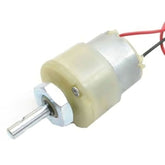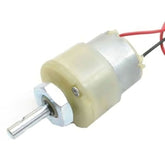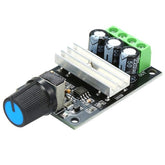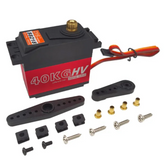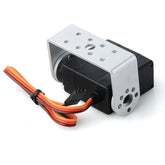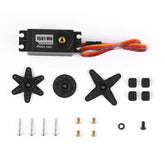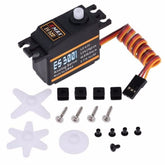What Is the Difference Between Servo Motor vs DC Motor – Explained Clearly
Summary
Looking for a motor to power your project? Two popular options are DC and servo motors. But what's the difference? In short, DC motors spin continuously while servo motors rotate to a precise angle. DC motors are cheaper and easier to control, but servo motors offer more accuracy and power. In this blog, we compare the pros and cons of each, including why servo motors are often preferred, and answer common questions like whether they use AC or DC power.
What is DC Motor?

A direct current (DC) motor is a type of electric machine that converts electrical energy into mechanical energy. DC motors take electrical power through direct current and convert this energy into mechanical rotation.
DC motors use magnetic fields that occur from the electrical currents generated, which power the movement of a rotor fixed within the output shaft. The output torque and speed depend upon both the electrical input and the design of the motor.
Check out Techniques for precise Speed Control of DC Motor.
What is a Servo Motor?

A servomotor (or servo motor) is a rotary actuator or linear actuator that allows for precise control of angular or linear position, velocity, and acceleration. It consists of a suitable motor coupled to a sensor for position feedback. Servomotors are used in applications such as robotics, CNC machinery, or automated manufacturing.
It also requires a relatively sophisticated controller, often a dedicated module designed specifically for use with servomotors. Servomotors are not a specific class of motor, although the term servomotor is often used to refer to a motor suitable for use in a closed-loop control system.
Get the Best Stability with MG996R Metal Gear Servo Motor!
Comparison between Servo and DC motor
When analyzing the DC motor vs servo motor, it's crucial to understand the distinctions in wire systems. The Servo motor operates on a three-wire system (power, ground, and control), setting it apart from the simpler two-wire system of the DC motor.
| Basic | Servo Motor | DC Motor |
| Wire system | The Servo motor is a wire system known as power, ground, and control. | DC motor is a wire system known as power and ground |
| Assembly | It has an assembly of four things DC motor, a gearing set, a control circuit, and a position sensor. | DC motor is an individual machine with no assembly. |
| Rotation | The Servo motor does not rotate freely and continuously like the DC motor. Its rotation is limited to 180⁰ | The movement of the DC motor is continuous |
| Examples | They are used in robotic arms, legs, or rudder control. | DC motor is used in car wheels, fans, etc. |
Check out Techniques for precise Speed Control of DC Motor.
Pros and Cons of DC motors:
In the ongoing debate of dc motor vs servo motor, let's delve into the pros and cons of DC motors. While DC motors excel in high-speed applications and continuous rotation, they may fall short in scenarios requiring precise angular movement
Pros:
- The DC motors are best suitable for high-speed applications.
- They are used in applications, where continuous rotation is required. Such as, Remote controlled cars, fans, and vibrators, etc..,
- The DC motor does not require any external circuit for speed control. By reducing the voltage, the speed can be reduced.
- These are available in different voltage levels. And has different variants and speeds.
- The DC motors can run for longer period of time.
Cons:
- The DC motors are not suitable for the application, where precise angular movement is required.
- These motors provide less torque without the external gear system attached to it.
Pros and Cons of Servo Motor:
Pros:
- The position of servo motors can be controlled more precisely than those of standard DC motors, and they usually have three wires (power, ground & control)
- As the servo motors are designed for precise angular movement, they are more suitable for applications where the angular movement should be accurate. So that, they are more suitable for the robotics application.
- The servo motors are available for wide range of torques and angular rotations.
- The servo motors can be easily interfaced with the microcontroller to obtain accurate angular rotation.
- There are many libraries available for different microcontrollers for interfacing the servo motor.
Cons:
- The servo motor can just rotate from 0-180 degrees. So it is not suitable for the applications where continuous rotation is required.
- The servo motor needs an external circuitry to control the angular rotation.
- The servo motor only be rotated electrically, if tired to apply force to rot externally, then the gear systems inside the servo motors may get damaged.
Why is a servo motor better than a DC motor?
As mentioned above the servo motor is mainly built to provide precise angular rotation. But the servo motor is also a kind of DC motor that is specifically designed to work based on the PWM signal. And also the servo motor has high torque as compared to the DC motor. This makes the servo motor more suitable for the application where you want to use any driver for precise angular rotation.
Is a servo motor a DC motor:

We can talk about servo motors as an assembly of four things: a DC motor, a gearing set, a control circuit, and a position sensor.
In industry, servo motors are known as motors that can be controlled most precisely. Comparing servos with standard DC motors, servos usually have three wires (power, ground, and control). Power to servo motors is constantly applied. The Servo controller regulates the current draw to drive the motor. These motors are designed for more specific tasks where position needs to be defined. Moreover, servo motors are used for accurate tasks, for example, to move a robotic arm or robot leg within a certain range, move a camera to a certain object and etc.
However, we must mention that servo motors do not rotate freely like a standard DC motor unless it’s modified for continuous rotation.
Do servo motors use AC or DC:
When it comes to the servo motors which are rated to drive very lower-powered applications, then the DC servo motors are used. But when used in industries, where high torque is required, there AC servo motors are preferred more than DC servo motors.
Also, read our blog What is Motor Driver detailing an overview of motor drivers, including the different types available and how they work.
Conclusion
In this blog post, we have learned that we've explored the key differences between DC motors and servo motors, as well as their respective advantages and disadvantages. While both types of motors have their strengths and weaknesses, the superior precision, speed, and control of servo motors make them a better choice for many applications. To answer the question of whether servo motors are DC or AC, the answer is both - servo motors can operate on either AC or DC power sources. So, whether you're building a robot, controlling a CNC machine, or any other high-precision application, a servo motor is a way to go for superior performance and control.
If you appreciate our work don't forget to share this post and leave your opinion in the comment box.
Please do check out other blog posts about Popular Electronics
Make sure you check out our wide range of products and collections (we offer some exciting deals!)





